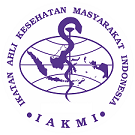Effects of Age, Safety Environment, and Fair Salary on Work Satisfaction
DOI:
https://doi.org/10.26911/thejhpm.2024.09.03.07Abstract
ABSTRACT
Background: Job satisfaction generally describes how satisfied a person is in carrying out their work. Job satisfaction can also be influenced by various factors such as competitive salaries, adequate staff numbers, a pleasant work environment, opportunities for growth and professionalism, reasonable workload, recognition by superiors, positive relationships with colleagues, autonomy at work, security. work, career advancement and fair rewards. This study aims to estimate the effect of age, a safe work environment and fair payment on the job satisfaction of health workers.
Subjects and Method: A systematic review and meta-analysis was conducted using PRISMA guidelines and the PICO model. The articles used range from 2014 to 2023. Population = Health workers. Intervention=age range >30 years, safe work environment, fair pay. Comparison= age range <30 years, unsafe work environment, fair pay. Outcome = job satisfaction. Articles were collected from databases such as Google Scholar, PubMed, and Science Direct. The literature search used the keywords "Safety Environment or Conducive Environment" AND "Fair Salary" AND "Health Provider" AND "Job Satisfaction" AND "Cross Sectional". A total of 9 articles met the inclusion criteria for meta-analysis, and were further assessed using RevMan 5.3.
Results: Meta-analysis with a cross-sectional study design of 9 primary study articles from Ethiopia and Myanmar showed that age over 30 years did not affect job satisfaction among health workers (aOR=1.00; 95% CI= 0.94 to 1.07; p= 0.940). A safe work environment (aOR= 1.23; 95% CI= 0.92 to 1.65; p= 0.160) can increase health workers' job satisfaction, but this increase is not statistically significant. Fair pay (aOR= 2.38; 95% CI= 1.78 to 3.19; p<0.001); can increase job satisfaction of health workers and these results are statistically significant.
Conclusion: Age over 30 years does not affect job satisfaction among health workers. A safe work environment can increase health workers' job satisfaction, but this increase is not statistically significant. Fair pay can increase health workers' job satisfaction and this result is statistically significant.
Keywords: safety environment, fair salary, health provider, job satisfaction
Keywords:
safety environment, fair salary, health provider, job satisfactionReferences
Alam A, Asim M (2019). Relationship Bet-ween Job Satisfaction And Turnover Intention. Int J Hum Resour Stud. 9(2): 2162–3058. Doi: 10.5296/-ijhrs.v9i2.14618.
Alrawahi S, Sellgren SF, Altouby S, Alwahaibi N, Brommels M (2020). The application of Herzberg’s two-factor theory of motivation to job satisfaction in clinical laboratories in Omani hospitals. Heliyon, 6(9). Doi: 10.1016/j.heliyon.2020.e04829
Ayalew F, Kibwana S, Shawula S, Misganaw E, Abosse Z, Van Roosmalen J, Stekelenburg J, Kim YM, Teshome M, Mariam DW (2019). Understanding job satisfaction and motivation among nurses in public health facilities of Ethiopia: A cross-sectional study. BMC Nurs., 18(1). Doi: 10.1186/s12912-019-0373-8
Bekru ET, Cherie A, Anjulo AA (2017). Job satisfaction and determinant factors among midwives working at health facilities in Addis Ababa city, Ethiopia. PLoS ONE, 12(2). Doi: 10.1371/journal.pone.0172397
Birkeland MS, Nielsen M., Knardahl S, Heir T (2015). Associations between work environment and psychological distress after a workplace terror attack: The importance of role expectations, predictability and leader support. PLoS ONE, 10(3): 1–8. Doi: 10.1371/journal.pone.0119492
Cleary M, Horsfall J, O’Hara-Aarons M, Hunt GE (2012). Leadership, support and acknowledgement of registered nurses work in acute mental health units. Int J Ment Health Nurs. 21(5): 445–452. Doi: 10.1111/j.1447-0349.2011.00804.x
Engeda EH, Birhanu AM, Alene KA (2014). Intent to stay in the nursing profession and associated factors among nurses working in Amhara Regional State Referral Hospitals, Ethiopia. BMC Nurs., 11(1), 13–24. Doi: 10.1186/1472-6955-13-24
Faeq DK (2022). The importance of emp-loyee involvement in work activities to overall productivity. J Human Edu Develop. 4(5): 15–26. Doi: 10.22161/-jhed.4.5.4
García-Juan B, Escrig-Tena AB, Roca-Puig V (2023). Structural empowerment and organisational performance: the mediating role of employees’ well-being in Spanish local governments. Int. J. Hum. Resour. Studies, 34(10), 1907–1939. Doi: 10.1080/09585192.2020.1859581
Gedif G, Sisay Y, Alebel A, Belay YA (2018). Level of job satisfaction and associated factors among health care professionals working at University of Gondar Referral Hospital, Northwest Ethiopia: A cross-sectional study. BMC Res Notes. 11(1). Doi: 10.1186/s13104-018-3918-0.
Geleto A, Baraki N, Atomsa GE, Dessie Y (2015). Job satisfaction and associated factors among health care providers at public health institutions in Harari region, eastern Ethiopia: A cross-sectional study. BMC Res. Notes, 8(1). Doi: 10.1186/s13104-015-1368-5
Geta A, Biks GA, Dellie E, Yazachew L (2021). Job Satisfaction and Associated Factors among Health Professionals Working at Public and Private Hospitals in Bahir Dar City, Northwest Ethiopia: A Comparative Cross-Sectional Study. BioMed Research International, 2021. Doi: 10.1155/2021/6632585
Green AE, Albanese BJ, Shapiro NM, Aarons GA (2014). The roles of individual and organizational factors in burnout among community-based mental health service providers. Psychol. Services, 11(1), 41–49. Doi: 10.1037/a0035299
Gregoriou I, Papastavrou E, Charalambous A, Economidou E, Soteriades ES, Merkouris A (2023). Organisational commitment, job satisfaction and intention to leave among physicians in the public health sector of Cyprus: A cross-sectional survey. BMJ Open, 13(5). Doi: 10.1136/bmjopen-2022-067527
Haitao N (2022). Relationship of Challenges, Recognition and Co-Workers to Job Satisfaction (Study of Human Resource Management Literature). Dinasti Int J of Digital Bus Manage. 3(2): 356–364. Doi: 10.31933/dijdbm.v3i2.
Jafari F, Behbahan SEB, Azami F, Gha-rahgozloi M, Tadayyon B (2014). Staff’s job satisfaction survey in Tehran’s teaching hospitals. Biomed Pharmacol J. 7(1): 9–16. Doi: 10.13005/bpj/446.
Jarupathirun S, De Gennaro M (2018). Factors of work satisfaction and their influence on employee turnover in Bangkok, Thailand. IJTech, 9(7), 1460–1468. Doi: 10.14716/ijtech.v9-i7.1650
Kibwana S, Yigzaw M, Molla Y, van Roos-malen J, Stekelenburg J (2018). Job satisfaction among anesthetists in Ethiopia—a national cross-sectional study. Int J Health Plan Manage. 33(4): e960–e970. Doi: 10.1002/-hpm.2573
Kristensen TS, Hannerz H, Høgh A, Borg V (2005). The Copenhagen Psychosocial Questionnaire-a tool for the assessment and improvement of the psychosocial work environment. Scand J Work Environ & Health, 31(6): 438–449. Doi: 10.5271/sjweh.948.
Kunze F, Raes AML, Bruch H (2015). It matters how old you feel: Antecedents and performance consequences of average relative subjective age in organizations. J. Appl. Psychol, 100(5), 1511–1526. Doi: 10.1037/a0038909
Lindberg P, Vingård E (2012). Indicators of healthy work environments - A systematic review. Work, 41(SUPPL.1), 3032–3038. Doi: 10.3233/WOR-2012-0560-3032
Memarian A, Aghakhani K, Moosavi Nezhad Baboli S, Daneshi S, Soltani S (2020). Evaluation of job satisfaction of forensic medicine specialists and comparison with job satisfaction of some medical specialists in Tehran. J. Family Med. Prim. Care, 9(6), 2710–2713. Doi: 10.4103/jfmpc.jfmpc_1167_19
Menon NK, Shanafelt TD, Sinsky CA, Linzer M, Carlasare L, Brady KJS, Stillman MJ, Trockel MT (2020). Association of Physician Burnout with Suicidal Ideation and Medical Errors. JAMA Netw. Open, 3(12), 1–12. Doi: 10.1001/jama-networkopen.2020.28780.
Mohammad AJ, Abdulrahman BS, Qader KS, Jamil DA, Sabah KK, Gardi B, Anwer, SA (2022). The mediation role of organizational culture between employee turnover intention and job satisfaction. Int J Teach Learn Educ. 1(4): 24–35. Doi: 10.22161/ijtle.1.4.3.
Paais M, Pattiruh JR (2020). Effect of Motivation, Leadership, and Organizational Culture on Satisfaction and Employee Performance. JAFEB. 7(8): 577–588. Doi: 10.13106/JAFEB.2020.VOL7.NO-8.577.
Redknap R, Twigg D, Rock D, Towell A (2015). Nursing practice environment: A strategy for mental health nurse retention?. Int J Ment Health Nurs. 24(3): 262–271. Doi: 10.1111/inm.12126.
Sato M, Maufi D, Mwingira UJ, Leshabari MT, Ohnishi M, Honda S (2017). Measuring three aspects of motivation among health workers at primary level health facilities in rural Tanzania. PLoS ONE, 12(5). Doi: 10.1371/journal.pone.0176973.
Scanlan LM, Devin SG, Watkins DL (2021). Job satisfaction of mental healthcare workers in multidisciplinary teams. J Ment Health. 30(1): 80–87. Doi: 10.-1080/09638237.2019.1644489.
Soe PP, Toe SY, Hnin ZL, Thant MM, Latt NN, Htay NHH, Aung TT, Sann M, Win NHH (2023). Job satisfaction among Myanmar working population, a cross-sectional study. Nagoya J Med Sci. 85(3): 444–454. Doi: 10.18999/nagjms.85.3.444.
Unsworth KL, Davis MC, Russell SV, Bretter C (2021). Employee green behaviour: How organizations can help the environment. Curr Opin Psychol. 42(1): 1–6. Doi: 10.1016/j.copsyc.2020.12.006.
Yatimul Kais D, Yuly P, Koesnadi (2022). Perception Analysis and Remuneration on Job Satisfaction of Health Officers at Nonggunong Public Health Center, Sumenep Regency. J Qual Public Health. 5(2): 417–424. Doi: 10.30994/jq-ph.v5i2.329.




